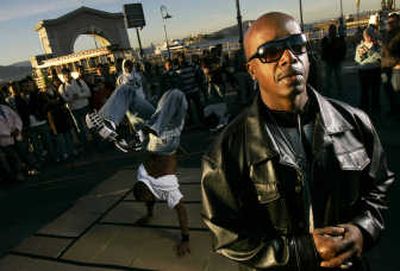Hammer charting a new career

SAN FRANCISCO – MC Hammer hasn’t topped the music charts since the early 1990s, but the former rap star says he has another hit in him – only this time around he’ll produce it as a Silicon Valley entrepreneur.
Hammer, whose real name is Stanley Burrell, is choreographing a new career as co-founder and chief strategy officer of Menlo Park-based DanceJam.com.
The Web site, scheduled to debut in mid-January, will try to upstage YouTube and become the Internet’s hub for sharing and watching dance videos. DanceJam then hopes to make money by grabbing a piece of the rapidly growing Internet advertising market, which is expected to rake in $27.5 billion in 2008, according to eMarketer.
If the business pans out, DanceJam could help Hammer compensate for losing his fortune when he went bankrupt in 1996 with nearly $14 million in debts.
The bankruptcy was a sobering comedown for Hammer, who parlayed the popularity of his once-ubiquitous song, “U Can’t Touch This,” to become a pop icon in the early 1990s. Besides becoming a fixture on MTV, Hammer appeared on kids’ lunch boxes and even had his own action figure.
Although Hammer isn’t churning out best-selling records any longer, everyone still seems to know his name. Even children born after his downfall are familiar with his music because it still gets played in TV shows and movies.
But Hammer’s involvement in DanceJam has more to do with technological savvy than celebrity, said Ron Conway, a longtime Silicon Valley investor who is part of a small group that provided DanceJam with $1 million in startup funds.
“I expect him to integrate all his knowledge into this Web site,” said Conway, who befriended Hammer at a baseball game seven years ago and has been tutoring him in the ways of technology ever since. “He is the lightning rod for this whole thing.”
Hammer, 45, started poking around Silicon Valley while he was still selling millions of records. He often hung out at computer makers like Silicon Graphics Inc. and Apple Inc., hoping to learn more about how technology might help his music career.
Hammer’s entrepreneurial roots date to the 1980s when he began recording songs with financial help from a few Oakland Athletics, where he once worked as a ball boy. His nickname came from his resemblance to the former home run king, Hammerin’ Hank Aaron.
Without the support of a major music label, Hammer built a loyal fan base by hitting the streets and selling his early recordings out of a car.
His success in grass-roots marketing prompted Salesforce.com Inc. to call on Hammer for advice in its early days. The company wanted to raise awareness about its online software service without paying a lot for traditional advertising, said Marc Benioff, Salesforce.com’s chief executive officer.
Hammer and his DanceJam partners – Geoffrey Arone, the chief executive, and Anthony Young, the chief technology officer – are wading into a market already saturated with dozens of Web sites that have built huge video libraries.
Arone became convinced the Web needed a site devoted exclusively to dance shortly after he left Web browsing startup Flock, which he had co-founded. Hammer had been feeling the same way for years so they quickly hit it off when they first met and created the concept for DanceJam.
Drawing upon the popularity of reality shows like “Dancing With The Stars,” DanceJam will stage competitions where contestants submit videos that will be judged by viewers. The site also will provide demonstrations and information about a wide variety of dances.
Arone, Hammer and Young have spent months videotaping people around the country dancing. They say they have stockpiled about 100 gigabytes of video to help launch DanceJam.
James McQuivey, a media analyst with Forrester Research, doubts that will be enough to lure people away from Google Inc.’s YouTube, which listed 1.7 million dance videos in its index as of late December.
“When people are looking for any video … they don’t stop to think about where’s the best place to find it. They just start off by going to YouTube,” McQuivey said.In fact, until he saw what YouTube was doing, Hammer had doubts about the Web’s entertainment value. “When everybody started raving about the Internet, I always wondered, ‘If it’s so great, why can’t you see my videos on the Internet?’ ” Hammer said. “It looks like technology has finally caught up with my vision.”